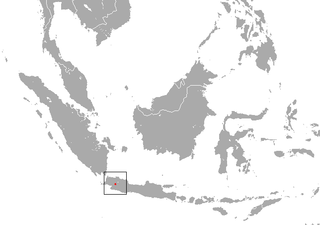
The Arabian shrew is a species of mammal in the family Soricidae. It is found in Oman and Yemen. They are solitary carnivores.

The Canarian shrew is a species of mammal in the family Soricidae. It is endemic to the Canary Islands, specifically the eastern islands of Lanzarote, Fuerteventura, Lobos, and Mount Clara. It used to be found on Graciosa, Canary Islands and Alegranza. Its natural habitat is subtropical or tropical dry shrubland. It is threatened by habitat loss.

The Southeast Asian shrew is a species of mammal in the family Soricidae. It is found in Cambodia, India, China, Laos, Malaysia, Myanmar, Thailand, and Vietnam.

The goliath shrew is a species of mammal in the family Soricidae. It is found in Cameroon, Central African Republic, Republic of the Congo, Democratic Republic of the Congo, Equatorial Guinea, and Gabon. Its natural habitat is subtropical or tropical moist lowland forests.

The Manenguba shrew is a species of mammal in the family Soricidae. It is endemic to Cameroon. Its natural habitat is subtropical or tropical moist montane forests.

The Sri Lankan long-tailed shrew is a species of mammal in the family Soricidae. It is endemic to Sri Lanka. It is threatened by habitat loss.

The montane white-toothed shrew is a species of mammal in the family Soricidae. It is found in Kenya, South Sudan, Tanzania, and Uganda. Its natural habitats are subtropical or tropical moist montane forest and subtropical or tropical seasonally wet or flooded lowland grassland. It is threatened by habitat loss.

The Somali dwarf shrew is a species of mammal in the family Soricidae. It is found in Ethiopia and Somalia. Its natural habitat is subtropical or tropical dry lowland grassland.

The black-footed shrew is a species of mammal in the family Soricidae. It is endemic to northern and central Sulawesi, Indonesia where it lives on the floor of the tropical forests. The International Union for Conservation of Nature has assessed its conservation status as being of "least concern".

The Oriental shrew is a species of mammal in the family Soricidae. It is endemic to Indonesia.

The pale gray shrew is a species of mammal in the family Soricidae. It is endemic to Pakistan and is distributed in the Shigar valley and the western edge of Deosai.

The Iranian shrew is a species of mammal in the family Soricidae. It is endemic to Iran. It is threatened by habitat loss.

The Tanzanian shrew is a species of mammal in the family Soricidae. It is endemic to Tanzania. Its natural habitat is subtropical or tropical moist montane forests.

The Saharan shrew is a species of mammal in the family Soricidae. It is found in Mauritania and Morocco. Its natural habitats are rocky areas and sandy shores.

The Cretan shrew is a species of mammal in the family Soricidae. It is endemic and exclusive to the island of Crete, Greece. Its natural habitat is temperate shrubland, and the animal is threatened by habitat loss. It is found in the mountainous highlands of Crete, having been displaced from lower altitudes by the lesser white-toothed shrew.

The jackass shrew is a species of mammal belonging to the Soricidae family. It is endemic to Turkey. Its natural habitat is rocky areas.

The thick-tailed shrew is a species of mammal in the family Soricidae. It is found on the islands of Java and Bali in Indonesia.

The Panay shrew is a species of shrew from the Philippines.
Crocidura guy is of species of shrew from Northeastern Vietnam, Viet Bac karst formation.

Brookesia desperata is a species of chameleons. It is endemic to Foret d'Ambre Special Reserve in north Madagascar, and is a critically endangered species due to the decline of its habitat. This decline is attributed to clearance of forest for crops, charcoal production, timber extraction, small-scale quarrying and cattle grazing. It was named desperata to provoke thought regarding the desperately threatened habitat of Madagascar's micro-endemic species. B. Desperata was discovered in 2012 by a research team led by Dr. Frank Glaw from the Zoologische Staatssammlung München.
This page is based on this
Wikipedia article Text is available under the
CC BY-SA 4.0 license; additional terms may apply.
Images, videos and audio are available under their respective licenses.




















